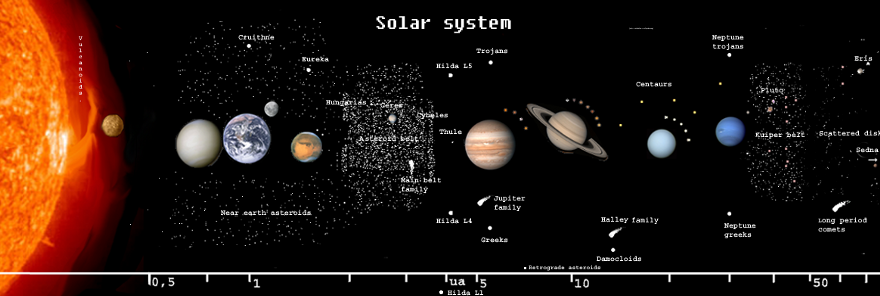
Black holes
Black holes are one of the most extreme objects of the universe: the mass concentration is so huge that it collapses into a singularity at its center, in full accord with the general theory of relativity. Atoms, nuclei and even fundamental particles crumble to an arbitrarily small thickness in our three-dimensional space. At the same time, everything that falls into it is doomed never to appear back, but simply to supplement its gravitational pull. What does this mean for dark matter? Our reader asks:
How does dark matter interact with black holes? Does it suck it into a singularity, like ordinary matter, and does it supplement the mass of the black hole? If so, what happens to it after the black hole evaporates through the Hawking radiation?
A great question, and start with what black holes are.

On Earth, to send something into space, it is necessary to overcome the gravitational attraction of the Earth. Our planet, what we call the second cosmic speed, equals 11.2 km / s, and it can be achieved by launching powerful missiles. If we were on the surface of the Sun, this speed would be almost 55 times greater, that is, equal to 617.5 km / s. After death, our Sun will shrink to a white dwarf whose mass is approximately 50% of the current mass of the Sun, and the size – to the size of the Earth. In this case, the second cosmic velocity on its surface will become 4570 km / s, or 1.5% of the speed of light.

Sirius A and B, Type of sun and white dwarf. Although the white dwarf is much smaller in mass, its small, terrestrial size makes the second cosmic speed much larger.

This is important, because the more mass you collect in One section of space, the closer to the light speed required in order to escape from this object. And when this speed on the surface of the object reaches or exceeds the speed of light, then it is no longer just light that can escape outward, it is already necessary – on the basis of our understanding of matter, energy, space and time – everything that is inside the object collapses into a singularity. The reason is simple: all the fundamental interactions, including forces holding atoms, protons and even quarks, can not move faster than light. So if you are somewhere outside the singularity point and are trying to keep the object further away from the gravitational collapse, you will not get anything done; Collapse is inevitable. And to overcome this limitation, you need a star more massive than the 20-40 mass of the Sun.

A massive star at the end of its life, with its iron core , Falling into and forming a black hole
When the fuel ends in the core, the center will collapse inside under its own gravity, and create a catastrophic supernova, dropping and destroying the outer layers, and leaving a black hole in the center. These BH “star mass”, the mass of which is about 10 solar, eventually grow, absorbing any matter or energy, dared to approach them too much. Even if you fall in BH at the speed of light, you can not get out. Due to the extremely strong curvature of the space inside, you will inevitably get into the singularity in the center. After that, you simply add the BH energy.

The black hole absorbs the accretion disk
Being outside can not tell if this BH Originally made of protons and electrons, neutrons, dark matter or even antimatter. The BH can measure, as far as we know, only three properties: mass, electric charge and angular momentum, that is, the speed of its rotation. In dark matter, as far as we know, there is no electric charge, no quantum numbers ( color charge, baryon number, lepton number, etc.) that could be preserved or destroyed according to the paradox of the disappearance of information in the BH.
Due to the BH formation principle (because of explosions of supermassive stars), at first after their occurrence, they are almost 100% composed of a normal (baryon) Matter, and 0% of dark matter. Remember that dark matter interacts only through gravity, unlike normal matter interacting through gravitational, weak, electromagnetic and strong interactions. Yes, of course, dark matter in large galaxies and clusters is about five times larger than normal, but this is when combined with a giant galactic halo. In a typical galaxy, this halo extends several million light years, spherically, in all directions, and normal matter is concentrated in a disk with a volume of 0.01% of dark matter.

Normal matter in the central disk and dark matter in the blue halo of a typical galaxy
The black holes are usually formed inside the galaxy, where normal matter dominates the dark one. Consider a section of space where we and our Sun are located. If you encircle it with a sphere with a radius of 100 AU. Around the solar system, we will include all the planets, moons, asteroids and almost the entire Kuiper belt, but the baryon mass – the normal matter – of what will be inside will be basically represented by the mass of the Sun and will be of the order of 2 * 10 30 Kg. On the other hand, the total amount of dark matter in this sphere will be 1 * 10 19 kg, that is, about 0.0000000005% of the mass of normal matter of the same site, which is approximately equal to the mass of a modest asteroid such as the small planet Juno, about 200 km across.

Over time, dark matter and normal matter will collide with this black hole, and it will absorb them, adding to their mass. Most of the growth of BH mass will come from normal matter, not dark matter, although at some point, quadrillion years later, the rate of BH decomposition will still exceed its growth rate. Hawking radiation will lead to the emission of particles and photons from the horizon of the black hole events, preserving all the energy, charge and angular momentum of the BH viscera. This process can take 10 years 67 years (for black holes with mass with the Sun) to 10 100 years (for the most massive BHs, whose masses are billions times more solar), but as a result A mixture of everything that is possible.

This means that BHs will also emit dark matter, but this does not depend on whether the concrete BH has at one time absorbed a dark matter . The black hole remembers only a small set of quantum numbers that has fallen into it, and the amount of dark matter that has fallen into it is not included in this set.

An example of Hawking’s radiation leaving the BH from areas near the event horizon (only qualitative illustration!)
So, in the end, dark matter is just another food source for BH, and not very good. It’s not even a particularly interesting source of food. The results of getting into the black hole of dark matter would not be different from the results of the experiment, in which you would shine in a flashlight, and it would absorb your photons. It is enough to pour into it, according to the equation E = mc 2 the same energy as dark matter fell into it in terms of mass. In dark matter, there are no other charges, and therefore, in addition to the angular momentum acquired due to a drop in the center of the black hole (which also applies to photons), it will not have any effect on the black hole.








